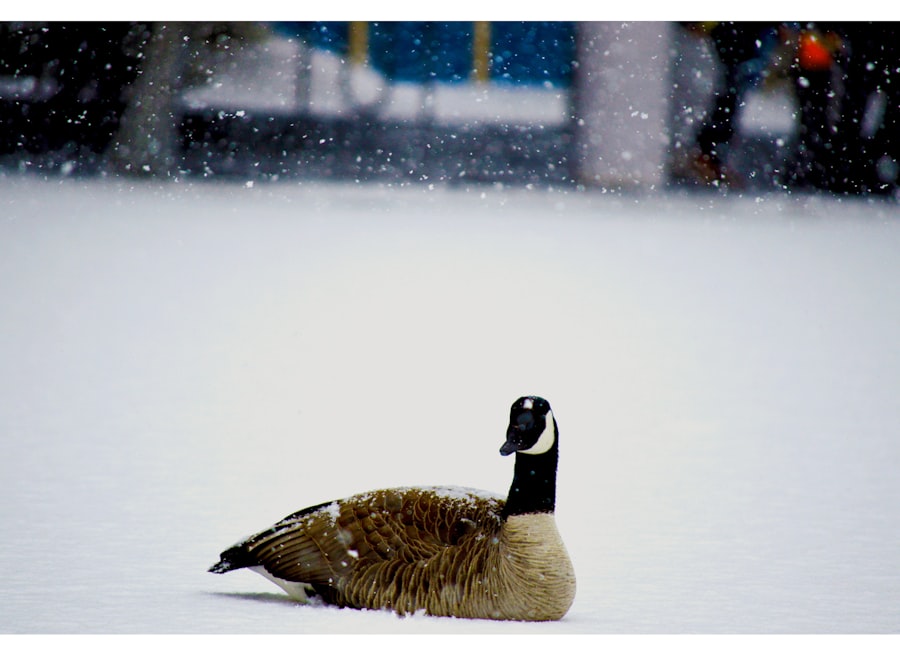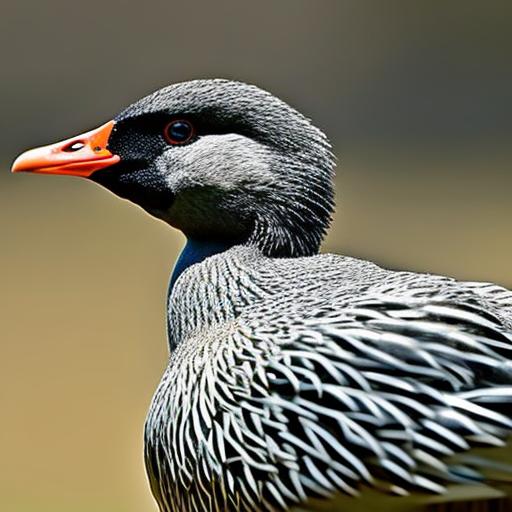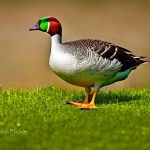Polywire is a type of electric fencing that is commonly used for keeping geese in secure enclosures. It is made up of multiple strands of wire that are woven together and coated with a layer of plastic. The wire is then electrified using a power source, creating a mild electric shock when touched. This shock acts as a deterrent, preventing the geese from crossing the fence boundary.
Polywire is a popular choice for geese enclosures for several reasons. Firstly, it is highly flexible and easy to work with, allowing for easy installation and customization. It can be easily adjusted to fit the specific needs of the enclosure, whether it be a small backyard or a large farm. Additionally, polywire is durable and long-lasting, able to withstand harsh weather conditions and the pecking and scratching of geese. It is also cost-effective compared to other fencing options, making it an affordable choice for geese owners. Lastly, polywire is safe for both geese and humans, as the electric shock it produces is mild and non-lethal.
Key Takeaways
- Polywire is a great option for keeping geese safe and secure.
- Benefits of using polywire for geese enclosures include affordability, flexibility, and ease of installation.
- There are different types of polywire for geese fencing, including electric and non-electric options.
- Setting up a safe and secure geese enclosure with polywire requires proper planning and installation techniques.
- Maintenance and repairs of polywire fences for geese are important to ensure their effectiveness and longevity.
Benefits of Using Polywire for Geese Enclosures
One of the main benefits of using polywire for geese enclosures is its flexibility and ease of use. Unlike traditional fencing options such as wood or metal, polywire can be easily adjusted and moved as needed. This makes it ideal for temporary enclosures or for areas where the layout may need to be changed frequently. Additionally, polywire can be easily cut to size and customized to fit any space, making it a versatile option for geese owners.
Another advantage of polywire is its durability and longevity. The plastic coating on the wire helps protect it from rust and corrosion, ensuring that it will last for many years. Additionally, polywire is designed to withstand the pecking and scratching of geese, making it a reliable choice for keeping them contained. This durability is especially important for geese owners who may have large flocks or who live in areas with harsh weather conditions.
Cost-effectiveness is another key benefit of using polywire for geese enclosures. Compared to other fencing options such as wood or metal, polywire is much more affordable. The materials needed for installation are relatively inexpensive, and the ease of installation means that labor costs are also reduced. Additionally, polywire requires minimal maintenance and repairs, further reducing long-term costs.
Safety is also a major consideration when it comes to geese enclosures, and polywire provides a safe option for both geese and humans. The electric shock produced by the wire is mild and non-lethal, acting as a deterrent rather than causing harm. This ensures that the geese are kept within the enclosure while also preventing any potential injuries to humans who may come into contact with the fence.
Understanding the Types of Polywire for Geese Fencing
When it comes to choosing the right polywire for geese enclosures, there are several factors to consider. One of the main considerations is the material and gauge of the wire. Polywire is typically made from either stainless steel or aluminum, with stainless steel being the more durable option. The gauge refers to the thickness of the wire, with a lower gauge indicating a thicker wire. Thicker wires are generally more durable and can withstand more pressure from geese.
In terms of choosing the right polywire for geese enclosures, it is recommended to use a stainless steel wire with a gauge between 14 and 16. This will provide the necessary strength and durability to withstand the pecking and scratching of geese. Additionally, stainless steel is resistant to rust and corrosion, ensuring that the wire will last for many years.
When selecting polywire, it is also important to consider the visibility of the wire. Geese have poor eyesight and may not be able to see thin or transparent wires, which could result in them accidentally crossing the fence boundary. It is recommended to choose a polywire that is highly visible, such as one with a bright color or reflective properties. This will help ensure that the geese can easily see and recognize the fence boundary.
Setting up a Safe and Secure Geese Enclosure with Polywire
Before installing polywire for a geese enclosure, it is important to plan and prepare the area. This includes measuring the space, determining the layout of the enclosure, and gathering all necessary materials. It is also important to ensure that the area is clear of any obstacles or hazards that could potentially damage the polywire or pose a risk to the geese.
When it comes to installation, there are several tips and tricks to keep in mind. Firstly, it is recommended to install posts at regular intervals along the fence line to provide support for the polywire. These posts should be securely anchored into the ground to prevent them from being knocked over by the geese or strong winds. Additionally, it is important to ensure that the polywire is properly tensioned to prevent sagging or drooping.
Proper grounding and electrical connections are also crucial for a safe and effective polywire fence. The power source should be connected to a grounding rod, which should be buried at least three feet deep in moist soil. This grounding rod helps dissipate any excess electrical charge and prevents the wire from becoming overcharged. It is also important to regularly check the electrical connections and ensure that they are secure and free from corrosion.
Maintenance and Repairs of Polywire Fences for Geese
Regular upkeep is necessary to ensure the longevity and effectiveness of polywire fences for geese enclosures. This includes inspecting the fence regularly for any signs of damage or wear, such as broken wires or loose connections. Any damaged or worn out polywire should be replaced immediately to prevent the geese from escaping or predators from entering the enclosure.
In addition to visual inspections, it is also important to regularly test the electrical charge of the polywire. This can be done using a voltmeter or an electric fence tester. The voltage should be within the recommended range for geese, which is typically between 4,000 and 5,000 volts. If the voltage is too low, it may not be effective in deterring the geese from crossing the fence boundary.
To ensure proper maintenance of polywire fences, it is recommended to trim any vegetation that may come into contact with the wire. This includes grass, weeds, and branches that could potentially short out the fence or reduce its effectiveness. Additionally, it is important to keep the area around the fence clear of debris or objects that could damage the wire or pose a risk to the geese.
Tips for Training Geese to Respect Polywire Fences

Training geese to respect polywire fences is an important step in ensuring that they stay within the enclosure. When introducing geese to a new enclosure, it is recommended to keep them confined within a smaller area initially. This allows them to become familiar with their surroundings and the presence of the polywire fence. Once they are comfortable and have established a routine, they can be gradually introduced to larger areas of the enclosure.
To encourage geese to stay within the boundaries of the polywire fence, it can be helpful to provide them with plenty of food and water within the enclosure. This will create a positive association with the space and make them less likely to venture outside of it. Additionally, it is important to regularly monitor the geese and reinforce the importance of staying within the fence boundaries.
Reinforcement can be done through verbal cues or physical barriers such as flags or tape. These visual cues can help remind the geese of the presence of the fence and discourage them from attempting to cross it. It is important to be consistent with reinforcement and to provide positive reinforcement when the geese stay within the enclosure.
Enhancing Geese Security with Polywire Electric Fences
Electric polywire fences provide an added layer of security for geese enclosures. These fences work by delivering a mild electric shock to any animal that comes into contact with the wire. The shock is not harmful, but it is enough to deter the geese from attempting to cross the fence boundary.
There are several benefits to using electric polywire fences for geese enclosures. Firstly, they provide a more effective deterrent compared to non-electric fences. The mild electric shock acts as a strong deterrent for geese, preventing them from attempting to cross the fence boundary. Additionally, electric polywire fences are highly visible, making it easier for geese to recognize and respect the fence boundaries.
Safety considerations are important when using electric polywire fences for geese enclosures. It is crucial to ensure that the voltage of the fence is within the recommended range for geese, which is typically between 4,000 and 5,000 volts. This voltage is strong enough to deter the geese but not strong enough to cause harm. Additionally, it is important to regularly test the fence voltage and inspect the electrical connections to ensure that they are secure and functioning properly.
Polywire Fencing for Geese Protection Against Predators
Polywire fencing can also provide protection against predators for geese enclosures. The electric shock produced by the wire can act as a deterrent for predators such as foxes, raccoons, or dogs. Additionally, the visibility of the wire can help prevent predators from attempting to enter the enclosure in the first place.
When setting up a predator-proof enclosure with polywire fencing, it is important to consider several factors. Firstly, it is recommended to bury the bottom strand of the polywire at least six inches deep to prevent predators from digging under the fence. Additionally, it can be helpful to install a predator apron, which is a strip of wire mesh that extends outwards from the bottom of the fence. This prevents predators from digging under the fence and entering the enclosure.
Other measures can also be taken to enhance predator protection in geese enclosures. This includes installing motion-activated lights or alarms near the fence to deter predators. Additionally, it is important to regularly inspect the fence for any signs of damage or weakness that could potentially allow predators to enter the enclosure.
Cost-effective Geese Fencing with Polywire
Polywire fencing is a cost-effective option for geese enclosures compared to other fencing options. The materials needed for installation are relatively inexpensive, and the ease of installation means that labor costs are also reduced. Additionally, polywire requires minimal maintenance and repairs, further reducing long-term costs.
When comparing the cost of polywire to other fencing options such as wood or metal, polywire is significantly more affordable. The materials needed for polywire installation, including the wire, posts, and insulators, are relatively inexpensive and readily available. Additionally, polywire can be easily installed by geese owners themselves, further reducing labor costs.
In terms of long-term cost savings, polywire is also a cost-effective option. The durability and longevity of polywire mean that it will last for many years without needing frequent repairs or replacements. This reduces the need for ongoing maintenance and replacement costs associated with other fencing options.
Why Polywire is the Ideal Option for Keeping Geese Safe and Secure
In conclusion, polywire is an ideal option for keeping geese safe and secure in enclosures. Its flexibility and ease of use make it a popular choice among geese owners, allowing for easy installation and customization. Polywire is also durable and long-lasting, able to withstand harsh weather conditions and the pecking and scratching of geese. Additionally, it is cost-effective compared to other fencing options and provides a safe environment for both geese and humans.
Understanding the different types of polywire available and choosing the right one for geese enclosures is crucial for a successful installation. Proper planning, preparation, and installation techniques are important for setting up a safe and secure geese enclosure with polywire. Regular maintenance and repairs are necessary to ensure the longevity and effectiveness of the polywire fence. Training geese to respect the fence boundaries can be achieved through positive reinforcement and consistent reinforcement of the importance of staying within the enclosure.
Electric polywire fences provide an added layer of security for geese enclosures, deterring both geese and predators from crossing the fence boundaries. Polywire fencing is a cost-effective option compared to other fencing options, providing long-term cost savings. Overall, polywire is the ideal option for keeping geese safe and secure in enclosures, providing a flexible, durable, and cost-effective solution for geese owners.
If you’re interested in keeping geese in with polywire, you may also find this article on Poultry Wizard helpful: “What Should You Feed Ducks?” This informative piece provides valuable insights into the dietary needs of ducks, offering guidance on the best food options to keep them healthy and thriving. Whether you’re a beginner or an experienced duck owner, this article is a must-read. Check it out here!
FAQs
What is polywire?
Polywire is a type of electric fencing made of polyethylene and metal wires that are woven together to create a conductive barrier.
Can polywire be used to keep geese in?
Yes, polywire can be used to keep geese in. It is a cost-effective and easy-to-install option for creating a temporary or permanent fence.
How does polywire work?
Polywire works by conducting an electric current through the metal wires woven into the polyethylene material. When an animal comes into contact with the fence, it receives a mild electric shock that deters it from crossing the barrier.
Is polywire safe for geese?
Polywire is safe for geese when used properly. The electric shock they receive is mild and does not cause harm, but rather serves as a deterrent to keep them from crossing the fence.
What are the benefits of using polywire to keep geese in?
Polywire is a cost-effective and easy-to-install option for creating a temporary or permanent fence. It is also highly visible, which helps to prevent accidental contact with the fence.
What are some tips for using polywire to keep geese in?
Some tips for using polywire to keep geese in include ensuring that the fence is properly grounded, keeping the fence free of debris and vegetation, and regularly checking the fence for damage or wear. It is also important to provide adequate shelter and food and water sources for the geese within the fenced area.
Meet Walter, the feathered-friend fanatic of Florida! Nestled in the sunshine state, Walter struts through life with his feathered companions, clucking his way to happiness. With a coop that’s fancier than a five-star hotel, he’s the Don Juan of the chicken world. When he’s not teaching his hens to do the cha-cha, you’ll find him in a heated debate with his prized rooster, Sir Clucks-a-Lot. Walter’s poultry passion is no yolk; he’s the sunny-side-up guy you never knew you needed in your flock of friends!







